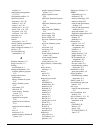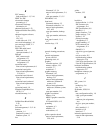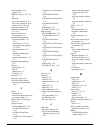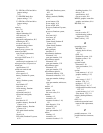
Compaq Deskpro 2000 Series of Personal Computers H-1
appendix
H
I
NTEL
440LX C
HIPSET
M
EMORY
L
IMITATIONS
The Intel 440LX Chipset has many functions, one of which is memory support. The Compaq
Deskpro 2000 Series of Personal Computers with the Intel Pentium II processor comes standard
with three DIMM sockets. Due to inherent architectural limitations, the Intel 440LX chipset does
not support any DIMMs comprised of ×4 (pronounced “by 4”) SDRAMs nor some combinations of
DIMMs with ×8 and ×32 SDRAMs in the 3-socket configuration. Below is a brief explanation of
how to determine whether a DIMM is ×4, ×8, or ×32.
Each SDRAM is essentially a large table of rows and columns. Each row corresponds to one
address. Each column in the row corresponds to a bit of data. When a row is accessed, it will
output all of the data in its columns for that row onto the data bus. The number of columns for
each SDRAM is either 4, 8, 16, or 32. This is referred to as the data width of the SDRAM and is
specified as ×4, ×8, ×16, or ×32.
The SDRAMs that make up a DIMM are built using either 16-megabit (Mb) memory technology or
64-Mb memory technology. This simply means that each chip is capable of storing either 16 × 10
6
bits of information or 64 × 10
6
bits of information.
The size of the SDRAM is given by stating the number of rows by the number of columns. When
multiplied together, the number of rows times the number of columns should equal the memory
technology used. Thus, a ×8 SDRAM built using 16 Mb technology has 2 × 10
6
rows. The total size
of the SDRAM is specified as 2M×8 bits. If the ×8 SDRAM was built using 64 Mb technology,
then there would be 8 × 10
6
rows and the total size of the SDRAM would be specified as 8M×8. By
knowing the width of each SDRAM, the total number of chips needed for each DIMM can be
determined.
To identify the SDRAM data width, use the total memory of the DIMM, the total number of
SDRAMs, and the information in Table H-1. Not all of the parameters are supported
configurations. The key to identifying unsupported memory configurations is to know the data
width (×4, ×8, ×16, or ×32) of the individual SDRAMs that make up the DIMM. The best way to
do this, although not foolproof, is to use the data presented in Table H-1. By knowing the total size
of the DIMM and how many SDRAMs are per side of the module, the memory technology and
data width of the SDRAMs can be determined.


















